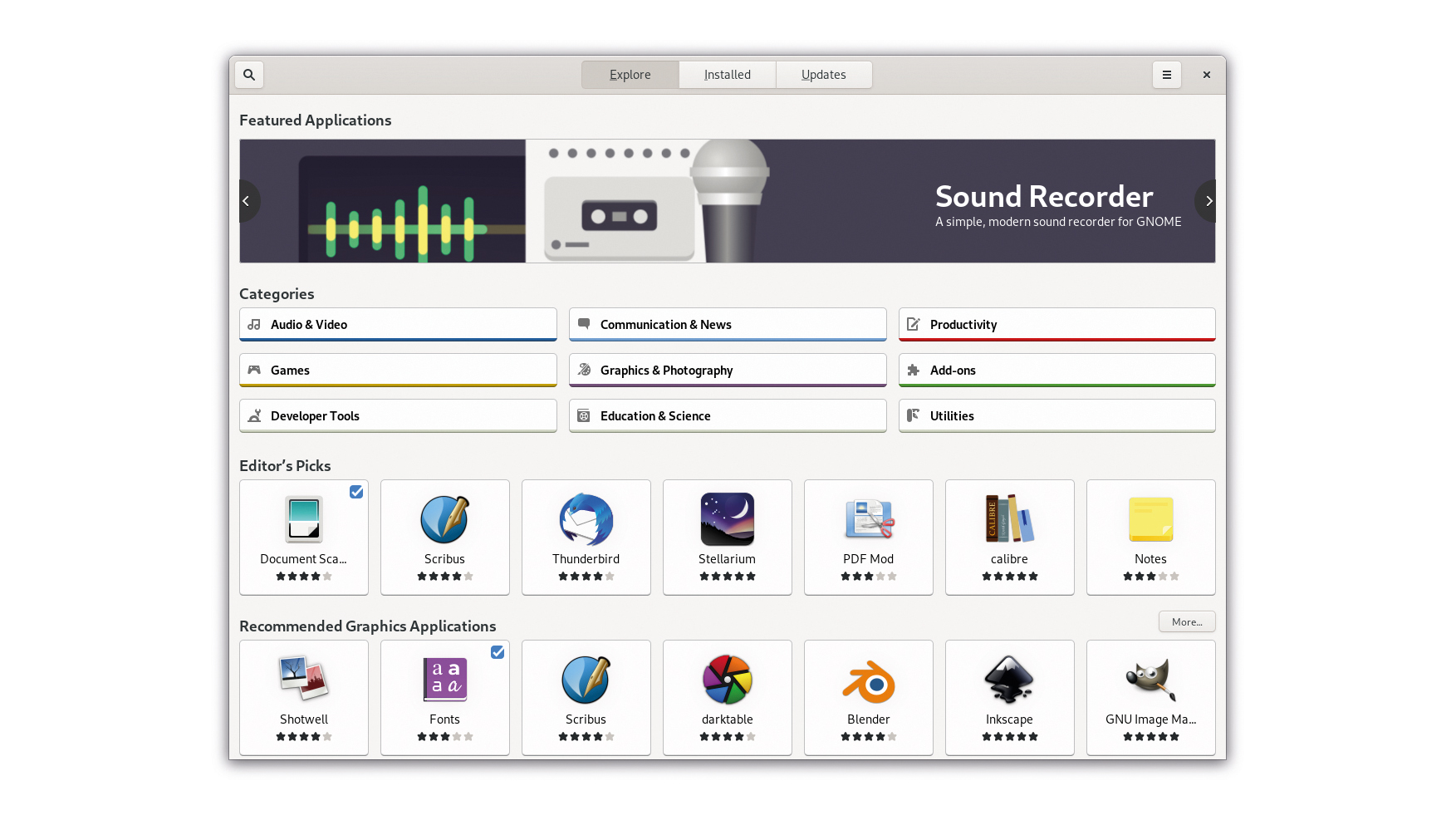Switch to Linux with these top distros
Windows 7 is dead; it might be time consider switching to a stable, secure and fast alternative

Fedora is the freely distributable offshoot of Red Hat, offering versions for standalone computers, servers, cloud computing, containers and IoT devices. We opted for the first, Workstation release 31, and installed it from a live image. We’d expect this build to be supported until around November this year, by which point Fedora 33 should be ready for download. (Fedora’s typical release cycle lasts six months, with only the two latest releases supported, so each installation is “current” for around 13 months, giving one month’s grace for slow upgraders to get themselves up to date.)
It was extremely easy to install. The live system picked up our Wi-Fi hardware, allowing us to connect to our wireless network pre-installation, and the settings carried through to the version set up on the hard drive. It also handled our laptop’s sleep-wake cycle better than many of its rivals: while most locked off the touchpad when we closed and reopened the lid, Fedora only lost its two-finger scroll function, but still let us drag the pointer with a single digit. The fix was the same as it had been elsewhere: to implement a script that unloaded the touchpad driver on sleep and reinitiated it on wake.
Fedora was in a minority of distros that sported only close buttons on window title bars. While minimising them isn’t a problem (Windows+down arrow), and neither was snapping them to the screen edges (Windows+left or right arrow), the absent minimise and maximise buttons could leave switchers wanting. Fortunately, the fix is a simple one, requiring a single line of code at the command line.
The default installation is slim but has all of the expected components, including LibreOffice, Firefox, a text editor, weather app, music player and file manager. There’s also Boxes, a virtual machine manager, which simplifies creating a VM locally or connecting to a remote computer. You can download an OS image directly to Boxes, supply your own or use one of the default choices, which include Ubuntu, Endless, Debian and openSUSE.
If the app you need isn’t installed, you’ll probably find it in the built-in app store, or you can install it through the terminal using RPM. You can add support for Snap for any packages not in the official repository.

Like the other distributions on test, Fedora spots which apps can handle different content types and indexes them appropriately. Thus, switching default apps for email, web, media and so on is just a case of picking the appropriate option within Settings, as it is in Windows. Alt+Tab cycles through live applications, as it does in Windows.
Tapping the Windows key shrinks all of the active windows to a multitasking view so you can switch between them, while simultaneously exposing a preselected search box. Start typing and Fedora immediately works on isolating results, with “music” pointing to Rhythmbox, “spreadsheet” to LibreOffice Calc and so on, despite the terms not appearing in the application names.
Dormant apps aren’t immediately accessible once you’ve opened the app menu; they’re a further click away behind the Show Applications button. However, once you’ve found them, your most frequently used apps have a tab of their own, which is handy, making them easier to locate. There’s no taskbar in the default desktop, which uses GNOME 3.
It’s easy to connect to your online accounts, with presets for Google, Facebook, Microsoft, Exchange, IMAP and others in the Settings app, which is where you’ll also find controls for notifications, privacy, which apps’ data is included in search results, desktop backgrounds and more.
Fedora spotted our networked scanner and printer, which were ready to use without additional drivers. Clicking the Network tab within the file manager likewise spotted our NAS drive, along with a selection of Macs, PCs and Raspberry Pi devices.
Fedora was snappy throughout our tests. Apps were responsive, remote drives were quick to mount, and in Geekbench 5 it turned in scores of 1,007 and 1,869 for single-core and multicore performance. The latter puts it slightly ahead of Ubuntu.
If you’re having trouble getting your hardware working in other distributions, take a look at Fedora. It was among the simplest to get up and running with, which perhaps explains why it’s said to be the distribution favoured by Linux father figure Linus Torvalds himself.
Get the ITPro daily newsletter
Sign up today and you will receive a free copy of our Future Focus 2025 report - the leading guidance on AI, cybersecurity and other IT challenges as per 700+ senior executives
Nik Rawlinson is a journalist with over 20 years of experience writing for and editing some of the UK’s biggest technology magazines. He spent seven years as editor of MacUser magazine and has written for titles as diverse as Good Housekeeping, Men's Fitness, and PC Pro.
Over the years Nik has written numerous reviews and guides for ITPro, particularly on Linux distros, Windows, and other operating systems. His expertise also includes best practices for cloud apps, communications systems, and migrating between software and services.
-
 Bigger salaries, more burnout: Is the CISO role in crisis?
Bigger salaries, more burnout: Is the CISO role in crisis?In-depth CISOs are more stressed than ever before – but why is this and what can be done?
By Kate O'Flaherty Published
-
 Cheap cyber crime kits can be bought on the dark web for less than $25
Cheap cyber crime kits can be bought on the dark web for less than $25News Research from NordVPN shows phishing kits are now widely available on the dark web and via messaging apps like Telegram, and are often selling for less than $25.
By Emma Woollacott Published
-
 Tiny11 review: Windows 11 with only 2GB of RAM
Tiny11 review: Windows 11 with only 2GB of RAMReview A version of Windows 11 for older machines that don't meet the full requirements
By Nik Rawlinson Published
-
 Red Hat Enterprise Linux becomes foundational operating system for Cohesity Data Cloud
Red Hat Enterprise Linux becomes foundational operating system for Cohesity Data CloudNews New strategic partnership between Red Hat and Cohesity aims to drive innovation in the data security and management space
By Daniel Todd Published
-
 Ubuntu shifts to four-week update cycle
Ubuntu shifts to four-week update cycleNews Critical fixes will also come every two weeks, mitigating the issues involved with releasing prompt patches on the old three-week cadence
By Richard Speed Published
-
 AlmaLinux follows Oracle in ditching RHEL compatibility
AlmaLinux follows Oracle in ditching RHEL compatibilityNews Application binary compatibility is now the aim with 1:1 now dropped
By Richard Speed Published
-
 How big is the Windows 10 cliff-edge?
How big is the Windows 10 cliff-edge?ITPro Network With some comparing the upcoming Windows 10 end of life to Windows XP, we ask members of the ITPro Network for their insight
By Jane McCallion Published
-
 Everything you need to know about the latest Windows 11 updates - from bug fixes to brand-new features
Everything you need to know about the latest Windows 11 updates - from bug fixes to brand-new featuresNews Two new cumulative updates are on the way and will be installed automatically on Windows 10 and Windows 11 machines
By Rory Bathgate Published
-
 How to download a Windows 11 ISO file and perform a clean install
How to download a Windows 11 ISO file and perform a clean installTutorial Use a Windows 11 ISO to install the operating system afresh
By John Loeppky Published
-
 We could all benefit from better Windows and macOS accessibility features
We could all benefit from better Windows and macOS accessibility featuresOpinion Today’s accessibility features can help you work through a nasty injury, but there’s still plenty of room for improvement
By Barry Collins Published